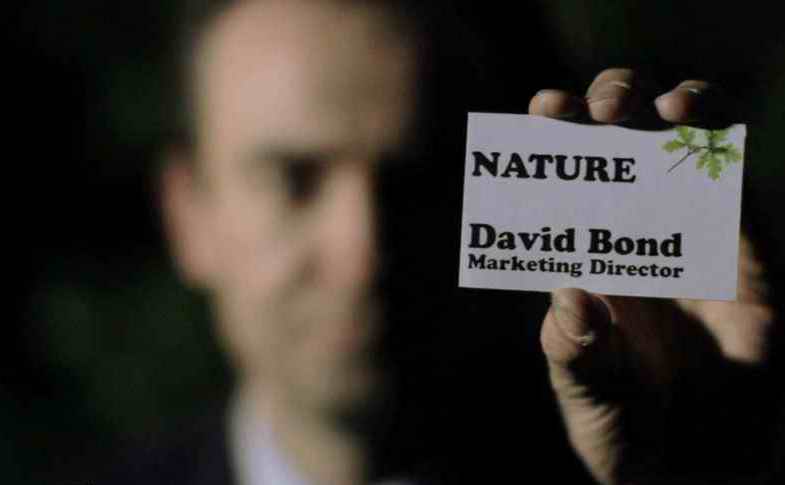Selling the Wildest Product: Nature
Director: David Bond
Cast: David Bond, Michael Depledge, Susan Greenfield
Length: 83 minutes
Country: UK
The battle between the man-made and the organic is one which tends to be rather one-sided. Why would we want to step out into a cold November day when we can sit in front of a screen and escape into any kind of sunny virtual reality we choose? It is this dilemma that has got David Bond worried. As director and protagonist of the new documentary film, Project Wild Thing, Bond takes this cold November day, brands it, packages it, and tries, quite literally, to sell it to children. Taking on the role of Marketing Director of Nature, Bond aims to get children disconnected from the virtual world and reconnected with the natural one. After failing to tear his two young children away from their screens to go outside to play (“my own family doesn’t use my product!” Bond exclaims), he sets out on the challenge to compete with the big brands and the mighty monopolies in selling a product that came way before even the original iPod. Nature.
Bond directs us on his journey from initial idea to the final Project Wild Thing product with the help of the many people he encounters. From scientists and specialists such as BBC Springwatch’s Chris Packham, the individuals that shine the most are the diverse range of children Bond interacts with. Some of the most delicate, natural and thought-provoking cinematography is of these young stars. Not long into the documentary, Bond visits the Hebridean Island of Eigg, where the outdoor world is a measurably larger part of the Island’s inhabitants’ lives. A young boy, one of the children from the local primary school, sits on a tree trunk surrounded by the greenest foliage and the single sound of birdcall; he picks and eats the leaves from a plant growing next to him. The young boy’s innocent munching is made to appear totally natural and undirected and for me, this moment is just one of the seemingly “captured” instances which literalise what it is Bond is aiming to do throughout: get more nature into children.
Project Wild Thing actually invades the enemy territory and demonstrates the benefits of using technology to spread an idea
The number of different children featured in the documentary, ranging from Bond’s own family to the teenage girls of a London secondary school, provide a lot of the bitter-sweet humour drizzled throughout. One particularly memorable individual is ten-year-old Mason, who guides Bond around his East-London housing estate. Portrayed as a place of confinement, the bleak car park and small patch of grass littered with dog mess is Mason’s outdoor world. Ball games, he says with such light-heartedness, would probably result in getting an ASBO. Although Bond’s focus in the documentary up until now has been to change children’s opinions of nature, here he comes to a turning point. Mason demonstrates the desire for children to run free and be wild and how this is just sometimes not available to them in the concrete jungle.
As well as some lovely moments of stillness, the documentary also offers us an insight into the bustling world of branding, marketing and just how influential these are in our daily lives. Now, you might expect that a documentary fighting for the appreciation of our natural environment would demonise technology and its displacement of the outdoors. Surprisingly, this is not the case. Instead of using the same brainwashing, bewitching spell that Apple has cast over our generation to block out the competitors, Project Wild Thing actually invades the enemy territory and demonstrates the benefits of using technology to spread an idea. Bond’s creative team design a website, an app and even a rap video to really develop the seed of Project Wild Thing into a fully grown and flourishing, cross-platform ‘brand’. This is what I found to be one of the more clever aspects of this particular documentary – of course the irony of using a film to get us outside is not lost on David Bond either. Letting us sit for 83 minutes and engage with Project Wild Thing is perhaps why I then felt guilty enough to choose the longer, more scenic walk to my lecture the next day.
Perhaps my only criticism of the film would be the ending. Although seeing Bond’s two young children stuff welly boots on his feet and drag him outside is a sweet enough image, I didn’t believe what I was seeing. The ending of the film feels a little unfinished, with the question having been posed but not entirely answered. However, it is understandable how a documentary will feel somewhat incomplete when attempting to divert the impenetrable force of the consumer away from their screens (“You’ve bought enough iPads now!”, Bond yells outside an Apple store) – not a simple task for anyone. It could be that the ending of Project Wild Thing intends to promote a idea of what it hopes can be the reality in the future – children desperate to get outside and have an adventure rather than get lost online.

Comments